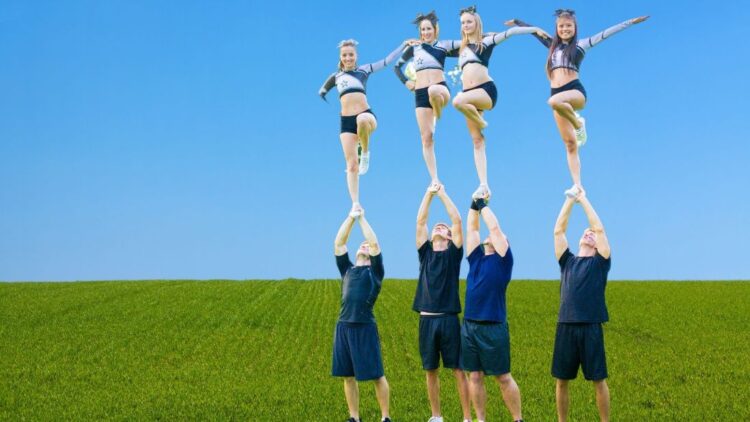
OBJECTIVE OF CHEERLEADING: Perform a routine that receives the highest score from the judges.
NUMBER OF PLAYERS: 5+ players
MATERIALS: Cheer uniform, poms
TYPE OF GAME: Sport
AUDIENCE: 6+
OVERVIEW OF CHEERLEADING

Cheerleading is a sport in which teams perform choreographed performances featuring a range of acrobatic and performative elements. As a competitive sport, cheerleading competitions are often held as tournaments where each team performs in front of a panel of judges.
Outside of competition, cheerleading is mainly associated with sporting events, such as football and basketball games. At these events, cheerleaders perform for the crowd’s entertainment during lulls in the game (such as timeouts or halftime). They also perform short celebratory routines when the team they’re associated with scores, such as after a touchdown in football, and play a vital part in school spirit.
Historically, cheerleading began in the 1860s when students began cheering and chanting at sporting events in Great Britain. This behavior soon came to the United States, with a “Sis Boom Rah” cheer emanating from college students at the first-ever collegiate football game in 1869 between Rutgers University and Princeton University.
By 1877, Princeton formed an organized cheerleading team, with cheerleading coaches, comprised entirely of all men. Surprising right? In 1898, a University of Minnesota student named Johnny Campbell became credited with being the first cheerleader in history after leading a crowd in a chant. Fun fact: cheers from the original Princeton team and from Campbell are still used by the two universities today!
It wouldn’t be until the 1940s, when many men were being drafted for World War II, that female cheerleading would take hold. By the 1950s, the first professional cheerleading team was formed: an all-female team that performed for the Baltimore Colts of the National Football League (NFL).
Since the mid-1950s, cheerleading has remained a female-dominated sport. Cheerleading is now a popular activity for children of all ages to participate in as an alternative to dancing.
There are many foundations that oversee the sport. These include the National Cheerleaders Association, the International Cheer Union, USA Cheer, and the Universal Cheerleaders Association.
SETUP
EQUIPMENT
- Cheer Uniform: Each team has a stylized uniform worn by all members. These uniforms are always tight-fitting, with some teams opting to include a skirt as part of their uniform.
- Poms: Also known as “pom poms”, these are round plastic props that appear as though they’re a tuft of wide metallic strings. Cheerleaders often hold these poms in their hands while performing, although they’re less common in competitive cheerleading events.
COMPETITION FORMAT
Cheerleading tournaments feature a huge collection of teams performing one at a time in front of a panel of judges. Each team performs a routine that is two minutes and thirty seconds long. In some more significant competitions, there may be rounds. But this depends on each competition!
These routines tend to be perfected during a summer cheerleading clinic, where the coaches and athletes spend long hours memorizing and execution the routines for competition.
GAMEPLAY

SCORING
There are various ways to score a cheerleading competition, depending on the competition organizer and the competition level of the teams. For the most part, however, all cheerleading routines are scored based on difficulty, execution, and overall impression.
1) DIFFICULTY
Depending on the competition level, all teams technically start their routines with a very high difficulty score to meet the demands of the competition. This is because each competition level has necessary elements that must be performed as part of the routine, meaning that every team starts with a similar difficulty score.
2) EXECUTION
Execution makes up the majority of a team’s final routine score. This score is mainly based on the execution of the technique used while performing various elements. Most of these elements fall into the categories of “building skills” or “tumbling skills”.
- Building Skills: Elements that include multiple competitors, such as pyramids and tosses.
- Tumbling Skills: Elements that often involve a single competitor, such as rolls, jumps, cartwheels, handsprings, twists, etc.
3) OVERALL IMPRESSION
Overall impression takes into account the creative elements of the routine, such as its composition, pace and flow, entertainment value, synchronization, and innovation. This is generally the scoring category worth the least amount of points. But with that said, it is still very important, considering competition winners often only win by a mere fraction of a point.
POINT DEDUCTIONS
In addition to these elements, judges can deduce points for major mistakes. These mainly include errors such as a fall, pyramid collapse, or bobble. In most cases, deductions are extremely costly, as these mistakes negatively impact the all-important execution score. Due to the huge cost of these deductions, the top teams of a competition are usually those that receive no deductions.
RULES
During a competition, cheerleaders must abide by the following set of rules:
- A competitor may not have anything in their mouth during a routine (gum, candy, etc.)
- No jewelry allowed during a routine
- Routines must not exceed two minutes and thirty seconds in length
- Each athlete must have at least one part of their body touching the ground at the start of their team’s routine
- All props must be approved prior to the competition
CHEERLEADING IN POP CULTURE
Cheerleading has long fascinated spectators from all over the world. While modern cheerleading teams like the Dallas Cowboys have garnered fans from all corners of the globe, competitive cheerleading has also had its fair share of spotlight and attention. Notably, a cult classic starring Kirsten Dunst, named Bring It On, was a movie centered around competitive cheerleading. More recently, documentaries like Netflix’s Cheer have shown just how brutal and challenging this sport can be!
Cheer | Official Trailer | Netflix
END OF GAME
The team that receives the highest overall score from the judges wins the cheerleading competition.
- 30 GAMES TO PLAY OVER TEXT - April 22, 2024
- 20+ FREE PRINTABLE BABY SHOWER GAMES - April 16, 2024
- 20+ College Party Games for the Best Night Ever! - April 2, 2024